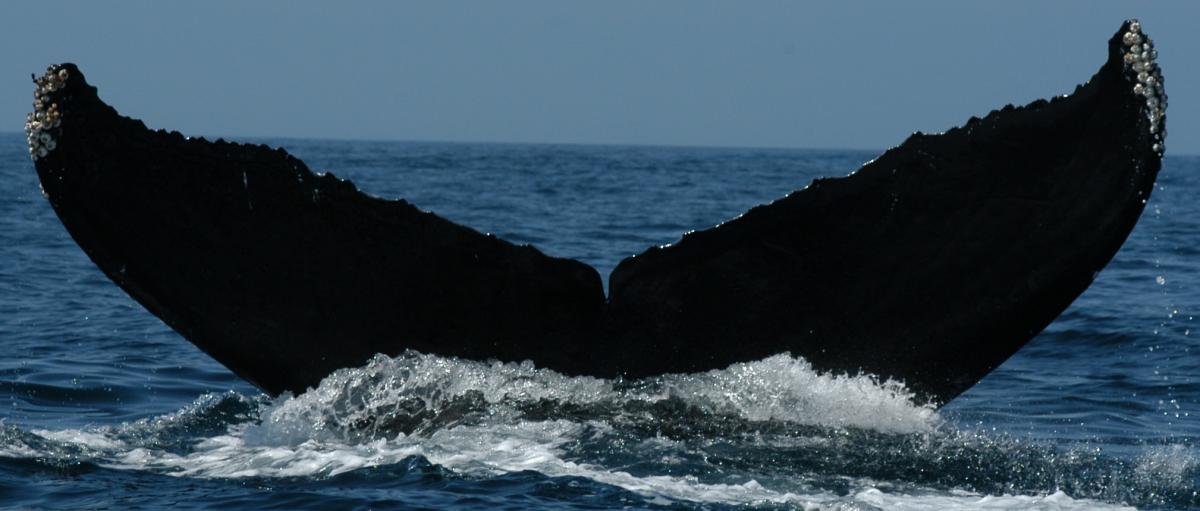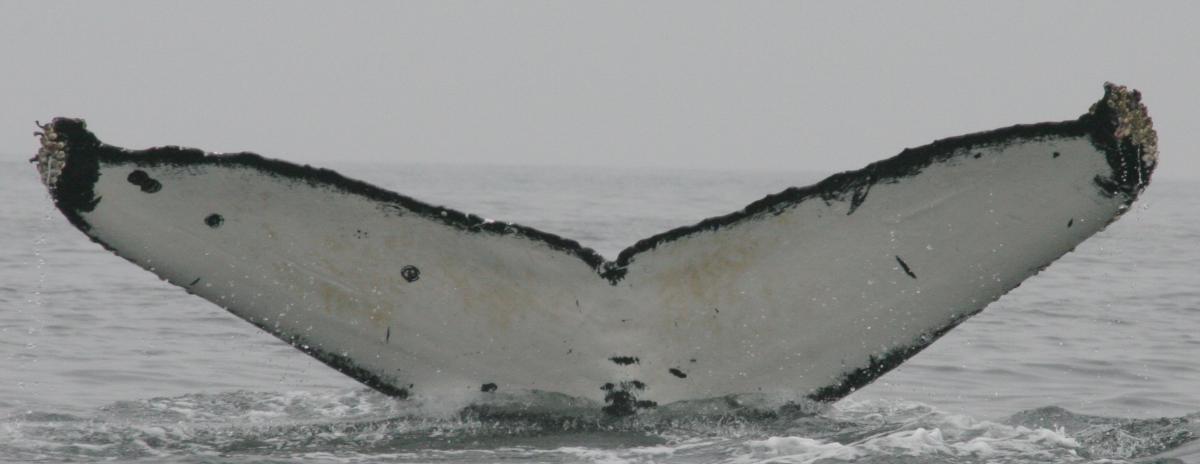

Two humpback whale flukes show the wide variation in markings

The dorsal fin and pigmentation pattern on the side of blue whales provide a fingerprint for identification.
Cascadia Research conducts long-term research on humpback and blue whales both along the West Coast of the United States as well as off Central America. We began this photo-identification research in 1986 and have continued annual surveys each year since. This photo-ID effort serves as the basis for the abundance estimates and trends for these species off the US West Coast. Cascadia also relies on contributions from a number of opportunistic sources (including citizen science) as well as collaborators to provide sighting information along with the photo-IDs. Through 2022 the humpback catalog includes more than 7100 unique individuals with just under 102,000 encounters of those individuals. And as of 2022 Cascadia’s blue whale catalog includes over 2700 individuals with over 19,000 encounters. In 2018 Cascadia Research under a contract with the National Oceanic and Atmospheric Administration (NOAA), Southwest Fisheries Science Center (SWFSC) took part in the California Current Ecosystem Survey (CalCurCea) and was able to conduct small boat surveys all along the US West Coast from northern Washington to southern California. For this project Cascadia followed a NOAA ship conducting line transects and surveyed areas of known whale concentrations collecting photo-ids and biopsy samples. Cascadia was also the principal organization conducting and coordinating the SPLASH humpback whale research effort from 2004-2006,and Cascadia was conducting the matching but also coordinated all efforts for US West Coast and Central America. Starting in 2020 Cascadia helped organized a SPLASH-2 effort with funding from NOAA. This effort did not include a field component but was more centered around pulling together researchers studying humpbacks since the initial SPLASH effort to help update the abundance calculation of humpbacks in the North Pacific Ocean and to update migratory pathways.
PURPOSES OF THE RESEARCH
The objectives of our research include:
- Determine the abundance of humpback and blue whales off California
- Determine trends in these populations
- Identify critical feeding habitats that need protection
- Monitor potential human-caused threats to large whale populations off California including ship strikes and sonar impacts
See additional information in these reports and publications by topic:
Humpback and blue whales off California, Oregon, and Washington
- Blue Whales Increase Feeding Rates at Fine-Scale Ocean Features (2022)
- Blue Whale Body Condition Assessed Over a 14-Year Period in the NE Pacific: Annual Variation and Connection to Measures of Ocean Productivity (2022)
- From Individual Responses to Population Effects: Integrating a Decade of Multidisciplinary Research on Blue Whales and Sonar (2022)
- Low Resighting Rate of Entangled Humpback Whales Within the California, Oregon, & Washington Region Based on Photo-Identification and Long-Term Life History Data (2022)
- Advanced Image Recognition: A Fully Automated, High-Accuracy Photo-Identification Matching System for Humpback Whales (2021)
- Comparing Uncertainty Associated with 1-, 2-, and 3D Aerial Photogrammetry-Based Body Condition Measurements of Baleen Whales (2021)
- Killer Whale Predatory Scarring on Mysticetes: A Comparison of Rake Marks Among Blue, Humpback, and Gray Whales in the Eastern North Pacific (2021)
- Sightings and Satellite Tracking of a Blue/Fin Whale Hybrid in its Wintering and Summering Ranges in the Eastern North Pacific (2021)
- Photo-Id of Individual Humpback Whales Using All Available Natural Marks: Implications for Misidentification and Automated Algorithm Matching Technology (2020)
- Updated Abundance Estimates for Blue and Humpback Whales Along the U.S. West Coast Using Data Through 2018 (2020)
- Extracting Identifying Contours for African Elephants and Humpback Whales Using a Learned Appearance Model (2020)
- Remoras Pick Where They Stick on Blue Whales (2020)
- Blue whale off Los Angeles yields surprising insights (July 2019)
- Assessment of Wound Healing of Tagged Gray and Blue Whales in the Eastern North Pacific Using Long-Term Series of Photographs (2017)
- Integral Curvature Representation and Matching Algorithms for Identification of Dolphins and Whales (2017)
- Trends in the Abundance of Humpback Whales in the North Pacific Ocean from 1980 to 2006 (2017)
- Update on abundance, trends, and migrations of humpback whales along the US West Coast (2017)
- A new web-based platform for ongoing large-scale photo ID linkage study of North Pacific humpback whales (2017)
- Publication on Biologically Important Areas for humpback and blue whales off the US West Coast in Aquatic Mammals, 2015
- Articles feature Cascadia’s research on whale feeding in Science News and Science magazine (January 2012)
Please click here to be taken to a searchable page for all of Cascadia’s publications.
Underwater behavior of blue, fin, and humpback whales using a variety of tags (suction-cup tags, satellite, etc.)
- Oceanic Giants Dance to Atmospheric Rhythms: Ephemeral Wind-Driven Resource Tracking by Blue Whales (2022)
- Blue Whales Increase Feeding Rates at Fine-Scale Ocean Features (2022)
- A Satellite-Linked Tag for the Long-Term Monitoring of Diving Behavior in Large Whales (2022)
- Scaling of Maneuvering Performance in Baleen Whales: Larger Whales Outperform Expectations (2022)
- Social Exploitation of Extensive, Ephemeral, Environmentally Controlled Prey Patches by Supergroups of Rorqual Whales (2021)
- Baleen Whale Prey Consumption Based on High-Resolution Foraging Measurements (2021)
- Predator-Scale Spatial Analysis of Intra-Patch Prey Distribution Reveals the Energetic Drivers of Rorqual Whale Super-Group Formation (2021)
- Sightings and Satellite Tracking of a Blue/Fin Whale Hybrid in its Wintering and Summering Ranges in the Eastern North Pacific (2021)
- Context-Dependent Variability in the Predicted Daily Energetic Costs of Disturbance for Blue Whales (2021)
- Lunge Filter Feeding Biomechanics Constrain Rorqual Foraging Ecology Across Scale (2020)
- Energetic and Physical Limitations on the Breaching Performance of Large Whales (2020)
- A Case Study of a Near Vessel Strike of a Blue Whale: Perceptual Cues and Fine-Scale Aspects of Behavioral Avoidance (2019)
- Extreme Bradycardia and Tachycardia in the World’s Largest Animal (2019)
- The Advantages of Diving Deep: Fin Whales Quadruple Their Energy Intake When Targeting Deep Krill Patches (2019)
- Differential Vulnerability to Ship Strikes between Day & Night for Blue, Fin, & Humpback Whales Based on Dive and Movement Data from Medium Duration Archival Tags (2019)
- Diving Behavior and Fine-Scale Kinematics of Free-Ranging Risso’s Dolphins Foraging in Shallow and Deep-Water Habitats (2019)
- Advances in Research on the Impacts of Anti-Submarine Sonar on Beaked Whales (2019)
- Context-Dependent Variability in Blue Whale Acoustic Behaviour. (2018)
- Body Flexibility Enhances Maneuverability in the World’s Largest Predator (2018)
- Using Digital Tags with Integrated Video and Inertial Sensors to Study Moving Morphology and Associated Function in Large Aquatic Vertebrates (2017)
- Context-Dependent Lateralized Feeding Strategies in Blue Whales (2017)
- A Multivariate Mixed Hidden Markov Model for Blue Whale Behaviour and Responses to Sound Exposure (2017)
- How Baleen Whales Feed: The Biomechanics of Engulfment and Filtration (2017)
- Living in a whale’s boundary layer: Swimming hydrodynamics of large vertebrates generate a low-drag ecological niche for commensal marine organisms (2017)
- Development of robust large whale satellite tags improves tag performance and reduces animal welfare problems (2017)
- New publication on blue and fin whale comparative feeding (26 June 2014)
Humpback whale research in Central America
- Abundance, Distribution, and Behavior of Humpback Whales (Megaptera novaeangliae) along the Pacific Coast of Nicaragua, Central America (2022)
- Evaluation of Mexico Distinct Population Segment of Humpback Whales as Units Under the Marine Mammal Protection Act (2021)
- Evaluation of Humpback Whales Wintering in Central America and Southern Mexico as a Demographically Independent Population (2021)
- Sighting & environmental characteristics of humpback whale breeding habitat off Pacific Central America: comparison of Northern and Southern Hemisphere populations (2017)
- Resighting patterns and behavior of humpback whales sighted in a tropical breeding ground off Guatemala (2017)
- Marine mammal monitoring in the Southwest Pacific State of Guerrero, Mexico (2017)
- Publication on humpback whale migrations in the Southern Hemisphere, Biological Letters
- Patterns of cetacean sighting distribution in the Pacific Exclusive Economic Zone of Costa Rica.Reprint from Rev. Biol Trop. (int. J. Trop. Biol.) 53: 249-263
- Cruise report for 1999 blue whale survey to Costa Rica Dome
- Report on Costa Rica humpback whale and other marine mammal research, 1996-2003
- Report on Costa Rica humpback whale and other marine mammal research, 1996-2002
To learn more about these research efforts please see the following: